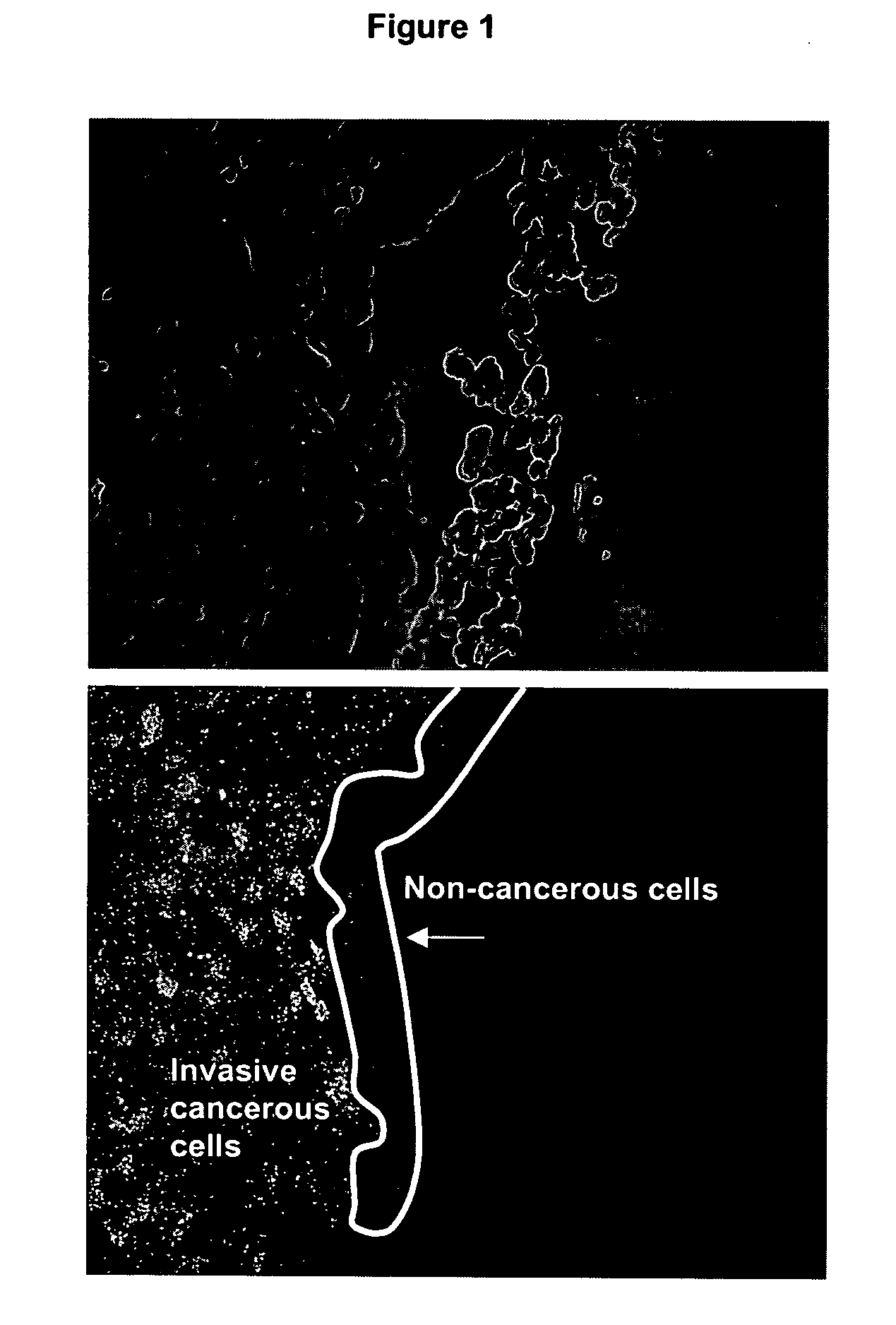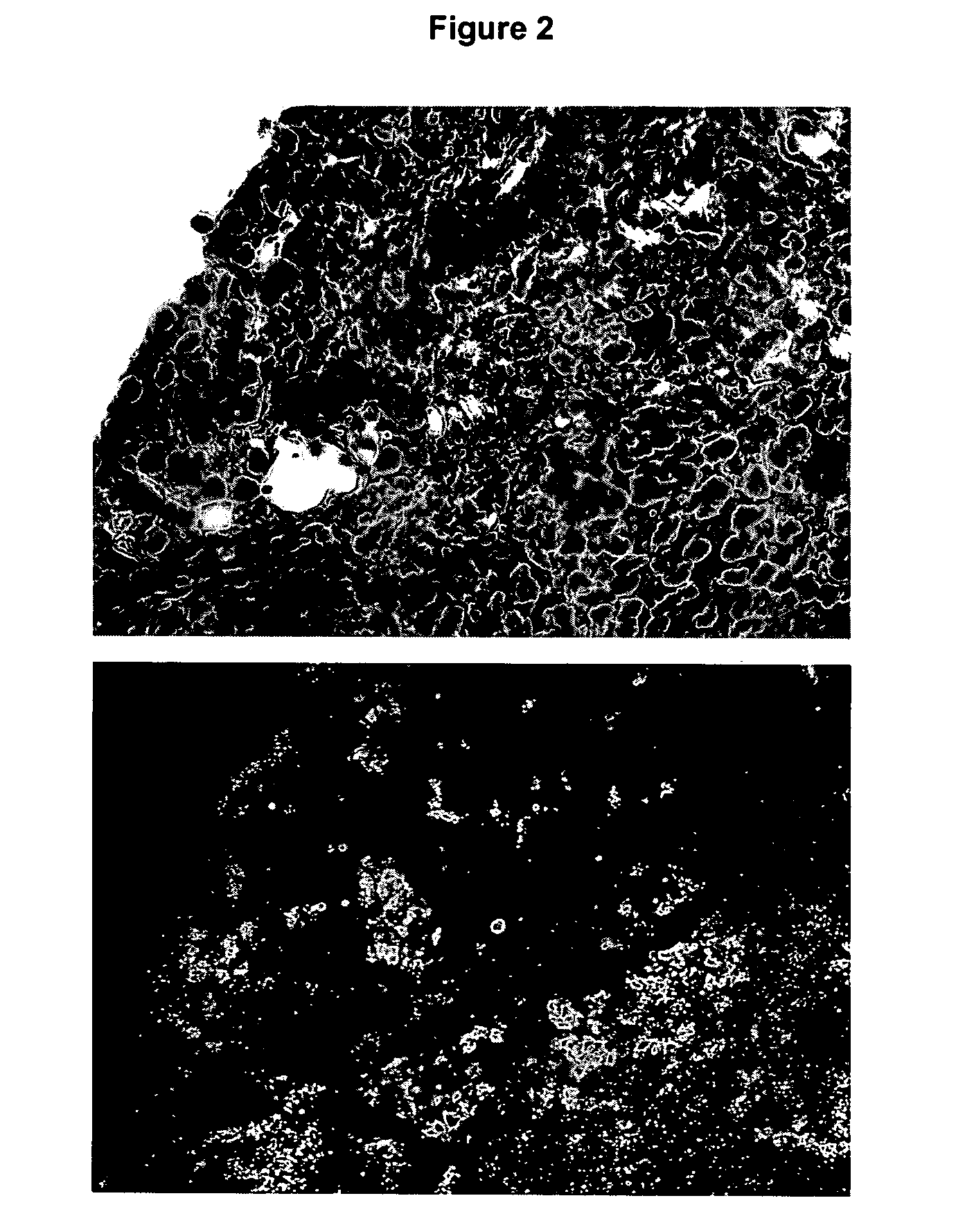Nucleic acid ligands to complex targets
a technology complex targets, which is applied in the field of nucleic acid ligands to complex targets, can solve the problems of difficult rational design of new ligands to the molecule, limited use of antibodies as tools, and difficult generation of new ligands to a specific target molecule, etc., to improve the ability to act, improve the ability to isolate, and improve the effect of amplifaction
- Summary
- Abstract
- Description
- Claims
- Application Information
AI Technical Summary
Benefits of technology
Problems solved by technology
Method used
Image
Examples
example 1
[0277] The following example relates to the isolation of a pool of nucleic acid ligands capable of differentiating between normal liver tissue and cancerous tissue.
[0278] Formalin fixed human tissue sections of colon tumour metastases in liver were prepared. Colon tumour metastases were identified in the liver tissue by standard histopathological procedures. A tissue section in which the tumourigenic tissue represented less than 10% of the total cell population in each section was selected.
[0279] A 10 micrometer thick tissue section was deposited on a glass slide and antigen retrieval performed by microwave irradiation of the tissue sample followed by ribonuclease A treatment.
[0280] One to fifty micrograms of a chemically random synthesised aptamer library of average size of 85 nucleotides containing a randomised section of 45 bases (2×1013 molecules per microgram) in 0.2 ml binding buffer (0.15 M NaCl, 10 mM phosphate pH 7.4, 5 mM MgCl2) was used. One million counts per minute o...
example 2
[0292] The following example relates to the isolation of a pool of individual aptamers that bind to specific molecules present in serum.
[0293] Serum proteins were concentrated and partially enriched by ammonium sulfate precipitation. The protein mixture was desalted by dialysis. Proteins were then immobilized on activated CH-Sepharose (Pharmacia) using conditions recommended by the supplier. Populations of beads were created with protein content varying between 1 and 25 microgram of protein per milligram of beads.
[0294] Alternatively the protein mixture was biotinylated with EZ-Link-sulfo-NH S-LC-Biotin (Pierce) which primarily reacts with free amino groups of lysine residues.
[0295] 10-50 micrograms of single stranded DNA aptamer library (>1×1014 molecules) was spiked with 32P end labelled library (1×105 CPM) was thermally equilibrated in binding buffer then added to underivatized CH— Sepharose to remove Sepharose binding species. The mixture was incubated at room temperature for...
example 3
[0310] Preparation of Aptamer Library
[0311] An 85 mer with a 45 base section of random nucleotide sequence was synthesized. The nucleotide sequence of the 85 mer is as follows:
5′-AGCTCAGAATAAACGCTCAANNNNNNNNNNNNNNNNNNNNNNNNNNNNNNNNNNNNNNNNNNNNNTTCGACATGAGGCCCGGATC-3′
[0312] The 85 mer was dissolved in water to a concentration of approximately 100 μM.
[0313] To generate a biotin labelled aptamer for use in screening, aN oligonucleotide with the following sequence was synthesized:
5′-GATCCGGGCCTCATGTCGAA-3′
[0314] This oligonucleotide was dissolved in water to a concentration of 100 μM. To anneal the oligonucleotide to the 85 mer, 25 μl of 100 μM 85-mer was mixed with 10 μl of 100 uM oligonucleotide, 30 μl Sequenase buffer (USB; 5×) and 94 μL water. The reaction was mixed and incubated at 68° C. for 5 minutes, the mix cooled to room temperature for 5 minutes and then chilled on ice for 2 minutes.
[0315] To the above mix was added 16.5 μl 0.1 M DTT, 12.5 μl 10 mM dNTPs, 1 μl Sequenas...
PUM
| Property | Measurement | Unit |
|---|---|---|
| Temperature | aaaaa | aaaaa |
| Fraction | aaaaa | aaaaa |
| Fraction | aaaaa | aaaaa |
Abstract
Description
Claims
Application Information
 Login to View More
Login to View More - R&D
- Intellectual Property
- Life Sciences
- Materials
- Tech Scout
- Unparalleled Data Quality
- Higher Quality Content
- 60% Fewer Hallucinations
Browse by: Latest US Patents, China's latest patents, Technical Efficacy Thesaurus, Application Domain, Technology Topic, Popular Technical Reports.
© 2025 PatSnap. All rights reserved.Legal|Privacy policy|Modern Slavery Act Transparency Statement|Sitemap|About US| Contact US: help@patsnap.com



